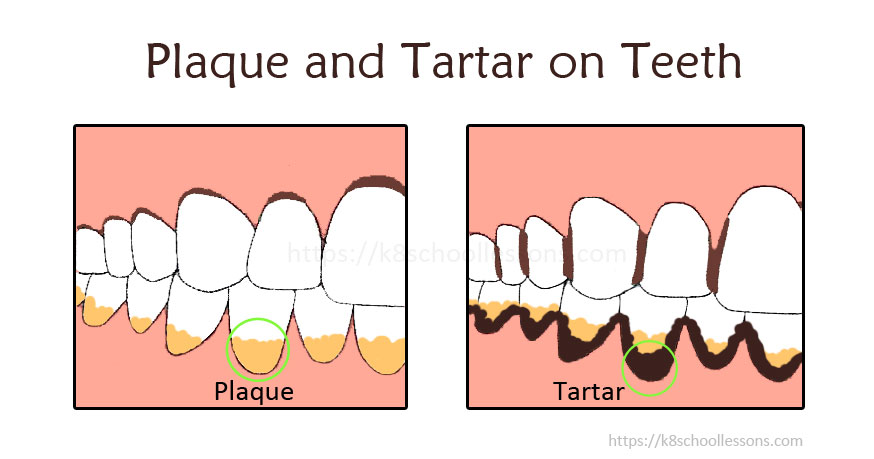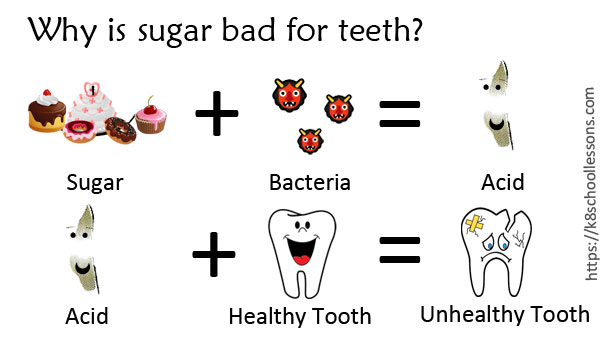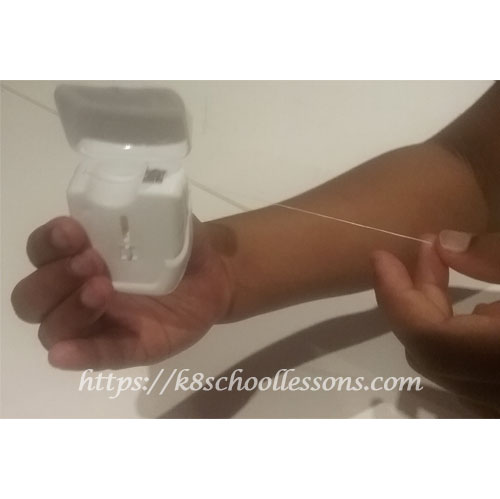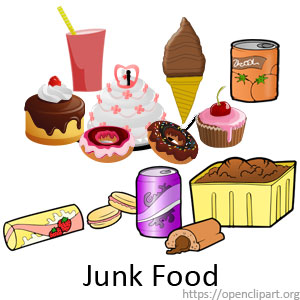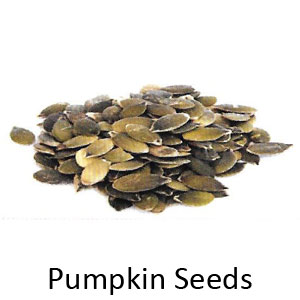Human Tooth Structure
Human tooth structure consists of enamel, dentin, the pulp and the cementum. There are 4 different types of teeth; incisors, canines, pre-molars and molars. This lesson, human tooth structure for kids, teaches you not only about human tooth structure, but also about tooth decay, preventing tooth decay and taking care of your teeth.
To learn all about Types of Teeth click here.
Human Tooth Structure for Kids
Unlike some of your body’s organs, such as brain, heart and lungs, your teeth were not prepared to function from the day you were born.
Tooth structure for Kids
Structure of the tooth
A tooth is basically made up of three parts.
- The crown
- The root
- The neck
The crown
he crown is the part which you can see when you smile or open your mouth. This is located above the gumline.
The root
This is the part of the tooth which you cannot see. It is located below the gumline and makes up about 2/3 of the tooth’s total length.
The neck
The neck of a tooth is the part between the crown and the root.
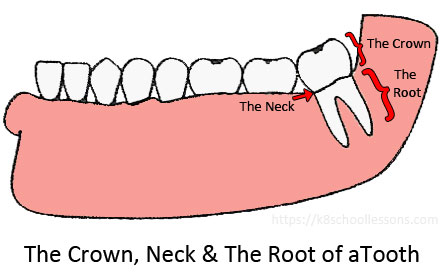 The Three Main Parts of a Tooth
The Three Main Parts of a Tooth
The crown and the root of a tooth consists of four different tissues. They are;
- Enamel
- Dentin
- The pulp
- Cementum
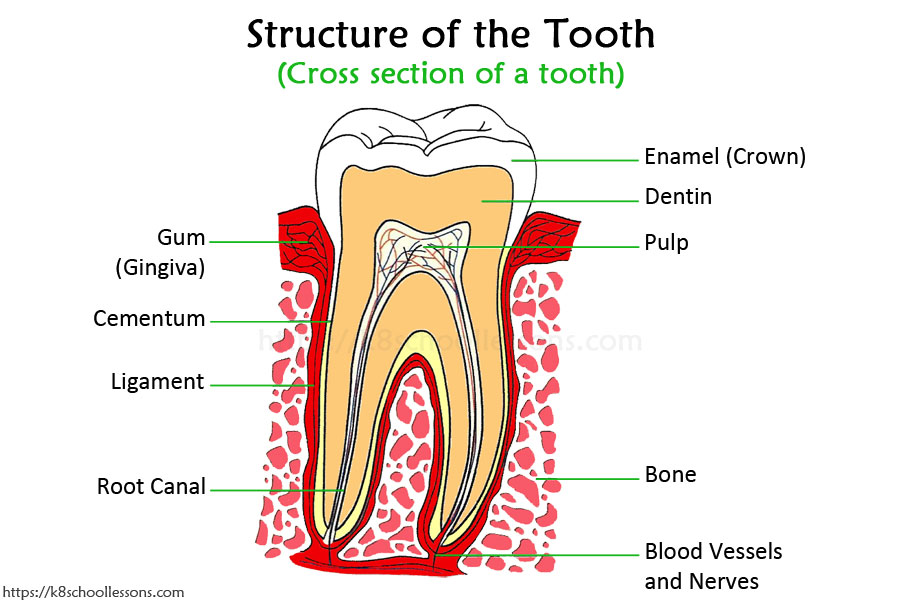 Cross Section of the tooth showing the Structure of the Tooth
Cross Section of the tooth showing the Structure of the Tooth
Enamel
If someone ask you, ‘what is the hardest thing in your body’, what would be your answer?
Believe it or not, it is a type of tissue that covers each of your teeth. We call this the enamel.
Enamel is the white covering of the tooth. It is a very tough and durable substance containing mineral salts, like calcium. It acts as a tooth’s personal bodyguard and protects the tooth from everyday wear and tear of chewing. Enamel also protects the inside parts of the tooth, working as a barrier.
Dentine
Dentine is a yellow bone-like material. It is softer than the enamel, but also very hard. Dentine consists of tubules (small tubes) with fluid inside, which help to transmit senses to the nerve. Dentine supports the enamel of the teeth and protects the innermost part of the tooth, called the pulp.
Pulp
Pulp is a soft tissue which is in the centre of the tooth. It consists of the tooth’s nerve endings and blood vessels. So, pulp helps to transmit signals to your brain and give nourishment to keep the tooth alive and healthy.
How do you know that your teeth have nerves?
Have you ever felt a pain in any of your teeth when having hot soup, or a cool ice-cream?
If you have a tooth which is hurting or a tooth with a cavity, you might have felt a pain in this tooth when having a bowl of hot soup, or a cool ice-cream. This indicates that your teeth have nerves, because to feel a pain you definitely need nerves to send the signals about the pain to the brain. In this case, it is the pulp of the tooth which actually hurts, because it is the part of the tooth which carries nerve endings. The nerve endings inside the pulp send messages to the brain about what’s going on. “Oh!!! The soup is too hot…. 🍵😧😧😧🍵!!!”
Cementum
Cementum covers most of the root of the tooth which is fixed to the jawbone. It helps to attach the tooth to the bones in your jaw. Between the cementum and the jawbone there is a cushioning layer to help connect them and acts as a cushion to absorb pressure. This is called the Periodontal Ligament.
The gumline
Gumline connects the tooth with the gum. Your gumline needs to have a great care as it collects plaque and tartar quickly if you do not brush or floss your teeth properly. This may cause gum disease.
Plaque and Tartar
What are plaque and tartar?
Plaque is a soft and sticky film that builds up on your teeth and contains millions of bacteria. It is formed on your teeth if they are not removed regularly through brushing and flossing. The bacteria in plaque cause tooth decay, gum disease and cavities in teeth.
Formation of plaque
Your mouth is a perfect breeding ground for bacteria. Usually, bacteria exist in your mouth. Tiny colonies of living organisms are constantly on the move on your teeth, gums, lips and tongue. This is completely normal as long as the bacteria are harmless. There are even helpful bacteria in your mouth.
However, without proper caring of your teeth these bacteria will turn out to be harmful. Bacteria can attach to the enamel of your teeth. If they are not removed regularly, they multiply and grow in number and form a colony. More and more bacteria can attach to the colony already growing on the enamel. Proteins in your saliva (or spit) also mix in, making the colony of bacteria a whitish film on the tooth. This film is what we call plaque.
Formation of tartar
Tartar is hardened plaque which has got collected on your teeth due to poor oral hygiene. Unlike plaque, tartar is easily visible. It is hard to remove tartar by brushing or flossing, so that you may need to see your dentist if you want to remove tartar.
Process of tooth decay
Tooth decay is one of the most common diseases in the world. However, it is non-contagious. Following are three simple steps to understand how tooth decay occurs.
Step 1: Bacteria in your mouth produce acid from food accumulated as plaque on tooth surface.
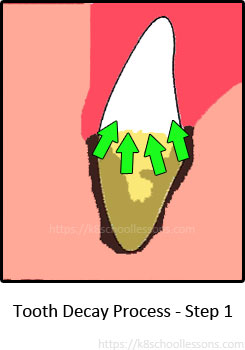 1st Step of the Process of Tooth Decay
1st Step of the Process of Tooth Decay
Step 2: This acid demineralises and weakens tooth surface.
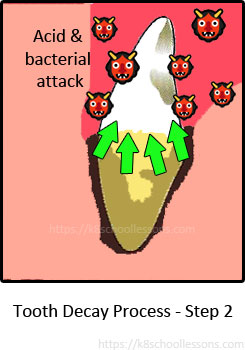 2nd Step of the Process of Tooth Decay
2nd Step of the Process of Tooth Decay
Step 3: In about 30 to 45 minutes, acid will be neutralized by saliva. Minerals in saliva will be absorbed into the tooth to remineralize it.
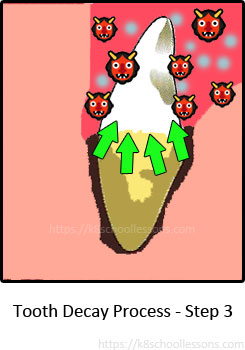 3rd Step of the Process of Tooth Decay
3rd Step of the Process of Tooth Decay
What is demineralisation?
Demineralisation is the loss of important calcium in your teeth.
Why is sugar bad for teeth?
Sugar plays a harmful role in tooth decay. The bacteria in plaque use sugar as a form of energy. They multiply faster and the plaque grows in size and thickness. Some of the bacteria turn the sugar into a kind of glue in order to stick themselves to the tooth surface, making it harder for the bacteria to get washed away with your saliva.
How is a tooth cavity formed?
Plaque produces acid as it eats up sugar. This acid cannot be easily washed away by your saliva. Mineral salts, like calcium in the enamel can easily be attacked and broken down by acids. In fact, this acid dissolves the minerals that make your tooth enamel hard. The surface of the enamel becomes porous, which means tiny holes appear. After a while, the acid causes the tiny holes in the enamel to get bigger until one large hole appears. This is a cavity.
Nerve fibres, which sends signals about the pain through the body, don’t exist in the tooth enamel. This is why, while the acid is attacking the enamel, you cannot feel a thing. The dentine is under the enamel. Once the acid eats into the dentine through the cavity, the nerve fibres begin to send out a message that something is going wrong. This message is about the pain which has occurred due to tooth decay.
Preventing tooth decay 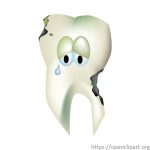
What is fluoride?
Fluoride is a natural element which helps prevent tooth decay. It works with saliva to protect tooth enamel from plaque and sugars. People who naturally have more fluoride in their drinking water have fewer cavities. Some communities put more fluoride in their water supplies to protect people against tooth decay. Fluoride mixes with tooth enamel when teeth are growing. But it can help prevent tooth decay even after your teeth are formed.
If your drinking water does not contain enough fluoride in it, you can have enough fluoride by using toothpaste containing fluoride, a mouthwash that has fluoride in it or having supplements like vitamins containing fluoride.
 Preventing Tooth Decay – Toothpaste containing Fluoride
Preventing Tooth Decay – Toothpaste containing Fluoride
What’s that awful smell?
Halitosis (Bad Breath)
If you don’t brush or floss your teeth properly, it may lead to halitosis, which means an offensive breath. Halitosis is generally known as bad breath.
Following are three common causes of bad breath:
- Food and drinks that we have – Food particles left in your mouth can rot and collect bacteria, starting to be smelly.
- Poor oral hygiene – If you don’t brush or floss your teeth regularly, a sticky, colourless film, called plaque builds up on your teeth. Plaque is an ideal place for bacteria to live and grow, leading to bad breath.
- Smoking and chewing smokeless tobacco – Smoking and chewing smokeless tobacco are the major causes of oral cancer. About one-fifth of the content of smokeless tobacco is sugar, and this causes a much greater risk of developing cavities. Smoking and chewing smokeless tobacco facilitate plaque and tartar accumulation.
Taking care of your teeth 
Following is a list of tips to take care of your teeth
Dos
-
- Brush your teeth regularly, at least twice a day (every morning and before bedtime) for 2-3 minutes each time, using a good toothbrush and toothpaste containing fluoride
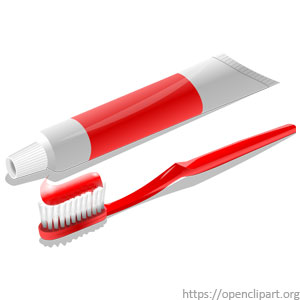 Brush your teeth regularly twice a day with a toothbrush and toothpaste containing fluoride
Brush your teeth regularly twice a day with a toothbrush and toothpaste containing fluoride
-
- Also, remember to brush your tongue well, because bacteria can grow there too.
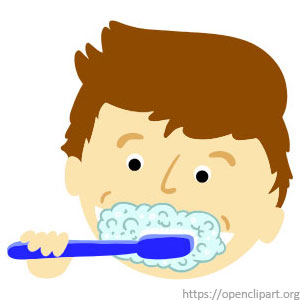 Also, brush your tongue well, when brushing your teeth
Also, brush your tongue well, when brushing your teeth
-
- Not only brushing, but also flossing once a day, helps to remove food debris in between your teeth and prevent plaque buildups.
-
- Always keep a separate toothbrush for you and make sure to clean it well after each brushing session.
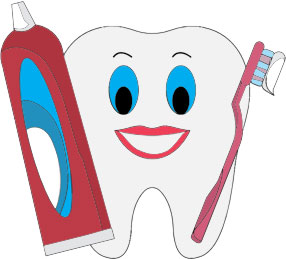 Always keep a separate toothbrush for you
Always keep a separate toothbrush for you
-
- Visit your dentist twice a year for regular checkups and cleanings is also, not a bad idea in order to know about your dental health.
 Visiting the dentist for regular checkups
Visiting the dentist for regular checkups
-
- It is better if you can rinse your mouth after every meal. Rinsing your mouth after eating or drinking something sweet is so much the better as sugar particles in your mouth accelerate the process of decaying your teeth.
-
- If you are a fan of fairly hard food like, corn, apples, celery, nuts, coconuts, carrots etc., by eating such food you give enough exercise for your teeth.
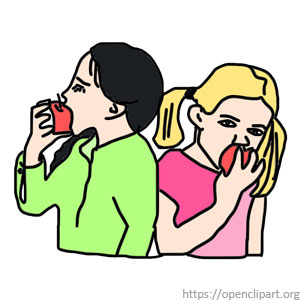 Eat fairly hard food like, corn, apples, celery, nuts, coconuts, carrots etc.
Eat fairly hard food like, corn, apples, celery, nuts, coconuts, carrots etc.
-
- Through a healthy balanced diet with calcium containing food like milk, fish, meat, fruit, you can keep your teeth strong and healthy.
Don’ts
-
-
- Other than using toothpicks, picking your teeth with sharp things such as pins or needles, is a very bad habit.
- Eating and drinking too much sweets is bad in every respect.
-
 Too much sweets is bad for your teeth
Too much sweets is bad for your teeth
-
-
-
- Using your teeth to open things like bottle lids, is also not advisable.
- Using another person’s toothbrush to brush your teeth is not alright at all.
- Putting dirty things or fingers in your mouth is not just bad for your teeth, but also for your entire body’s health.
-
-
So, keep up with all the do’s of taking care of your teeth for a strong and healthy set of teeth and odour free breath!
What is flossing?
Cleaning your teeth with dental floss is called flossing. Dental floss is a piece of waxy string made of nylon that comes on a spool.
Advantages of flossing:
-
-
-
- Removing the food particles that your brush cannot reach
- Removing plaque stuck in between teeth
- Removing hard plaque on teeth
-
-
Eating healthy for healthy teeth
Food bad for teeth
Following is a list of food bad for the your teeth.
-
-
-
- Doughnuts
- Cookies
- Cakes
- Ice-cream
- Fruit canned in syrup
- Flavoured milk (Chocolate milk, strawberry milk)
- Milkshakes
- Flavoured coffee
- Fizzy drinks like coke
- Sports drinks
- Any type of Candy
- Flavoured cereal
- Nougats
- Fruit juice
- Starchy food
-
-
These are only a few types of food which is bad for your teeth, if you eat too much of them without proper caring.
Eating food containing calcium is very good to keep your teeth healthy. Dairy products are good source of calcium and an essential nutrient for the development of bones and teeth.
Food for healthy teeth and gums
-
-
-
- Milk – Enriched with calcium, milk helps teeth grow stronger and less prone to fracture or damage.
-
-
-
-
-
- Cheese – Eating cheese helps to protect your teeth from cavities by preventing demineralisation.
-
-
-
-
-
- Apples – Contain lots of water and, this helps to regulate oral acidity so that bacteria won’t sustain on your teeth.
-
-
-
-
-
- Berries – Contain lots of vitamin C which helps to control bacteria and is important for the health of gum tissue.
-
-
-
-
-
- Carrots – Rich in vitamin A that strengthens the enamel, which is the outer covering of your teeth.
-
-
-
-
-
- Celery – Eating celery requires extra chewing that helps massaging gums and cleans between teeth so to keep them healthy and clean.
-
-
-
-
-
- Eggs – Contain phosphorus and combining with calcium and vitamin D to create our bones system. These elements keep teeth stronger and healthier by protecting them from teeth decay.
-
-
-
-
-
- Pumpkin seeds – A very good source of beta-carotene, Omega 3, minerals like magnesium and manganese, zinc and copper. The oil in the seeds also helps to strengthen enamel on teeth.
-
-
-
-
-
- Nuts – Rich in calcium, magnesium and phosphate, which are important nutrients for dental health. Nuts good for teeth are cashews, peanuts, almonds and walnuts.
-
-

Food good for teeth Eggs
-
-
-
- Green Tea – Contain fluoride which helps protect tooth enamel from decay and promotes healthy teeth.
-
-
As you know by now, saliva helps to wash food particles from your mouth and lessen the damage from acid. Eating a snack during a meal, usually has less threat to teeth because of the additional saliva produced during the mealtime eating. But you should be wise enough to choose the snack, which doesn’t contain too much sugar.
Hope you’ve learned a great deal about your teeth with this lesson ‘human tooth structure for kids’.

